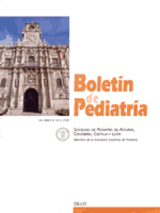El test de dibujo de la familia en pacientes con problemas del habla
M. Pelaz , J.A. Gil Verona , J.M. Coca , J.F. Pastor , I. Álvarez , J. Catalina , S. Aguilar , B. Bodega
Bol. Pediatr. 1999; 39 (167): 34 - 37
Fundamento: Para conocer el origen de la tartamudez utilizamos pruebas proyectivas, que permiten al niño expresar sus emociones, conflictos y tensiones, con un lenguaje gráfico. Verbalmente no sería posible comentar sus problemas, porque el niño utiliza frecuentemente como mecanismo de defensa la negación de una realidad que le resulta penosa. Métodos: Presentamos un estudio realizado en la Unidad de Logopedia de la Facultad de Medicina de Valladolid, con 32 pacientes (22 niños y 10 niñas) de edades comprendidas entre 7 y 10 años, diagnosticados de disfemia y a los que se les ha pasado, entre otras pruebas, el test de dibujo de la familia. Estudiamos la preferencia-identificación, valoracióndesvalorización. Resultados: El personaje dibujado en primer lugar, el más importante, es el padre en el 41,6% de los casos, seguido de la madre en el 22,20%. La identificación es en la mayoría de los casos de deseo (47,22%) seguida de la de realidad (38,8%). Conclusiones: Nuestros resultados confirman la tesis de la fuerte presión que ejerce la agresividad en un gran número de pacientes disfémicos.
Family drawing test in patients with speaking problems
Basis: In order to know the origin of the stammering, we can use proyective tests, that allow the children to express their emotions, conflicts and stress. It couldn?t be possible to express their problems verbally, because, the children frequently, use as a defence mechanism, the negation of a reality that is painful. Methods: In this paper we present a research that has been done in the Logopeadic Department of the Medicine Faculty of Valladolid (Spain), with 32 patients (22 males and 10 females) with age between 7 and 10 years old, diagnosed of stammering, that have realised, among another test, the drawing family test. We have studied the preference-identification, valuation-devaluation. Results: The person first drawed, the most important, is the father in the 41.6% of the cases, followed by the mother in the 22.20%. The identification is in the most of the cases of desire (47.22%) followed by the reality one (38.88%). Conclusion: Our results confirm the idea that the strong pressure that aggressiveness exert on a great number of stammered patients.
Artículo completo (PDF) (27 kb.)
- Psicología
